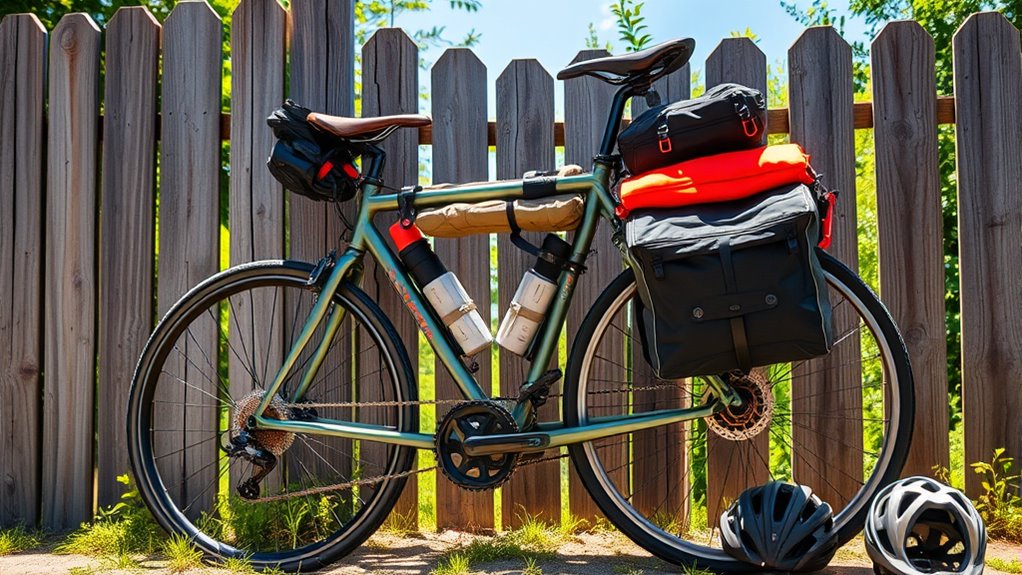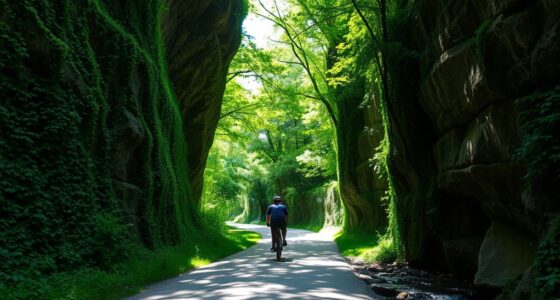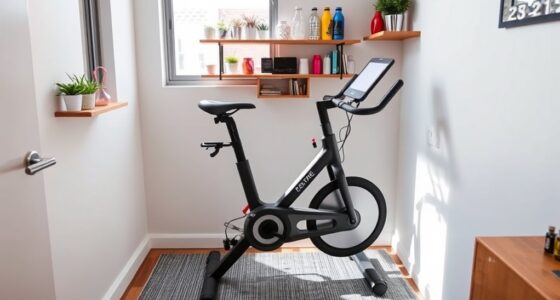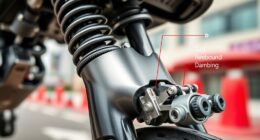To pack like a pro for your first bikepacking trip, focus on essential clothing like moisture-wicking shirts, bike shorts, and layered gear for changing weather. Pack lightweight sleeping gear, hygiene items, and quick-eating snacks. Bring navigation tools, repair kits, and safety gear, including lights and a whistle. Organize your gear with accessible compartments, prioritize quick needs, and keep valuables secure. For a smooth adventure, continue exploring this thorough checklist to guarantee you’re fully prepared.
Key Takeaways
- Prioritize lightweight, moisture-wicking clothing and essential safety gear for comfort and visibility.
- Pack durable, compact cooking and food storage supplies, along with non-perishable snacks and hydration tools.
- Include navigation devices, repair kits, and safety accessories like reflective gear and signaling tools.
- Organize belongings for quick access, keeping frequently used items within easy reach and properly secured.
- Remember hygiene essentials, biodegradable waste disposal, and respect trail etiquette for a safe, mindful adventure.
Essential Clothing and Gear
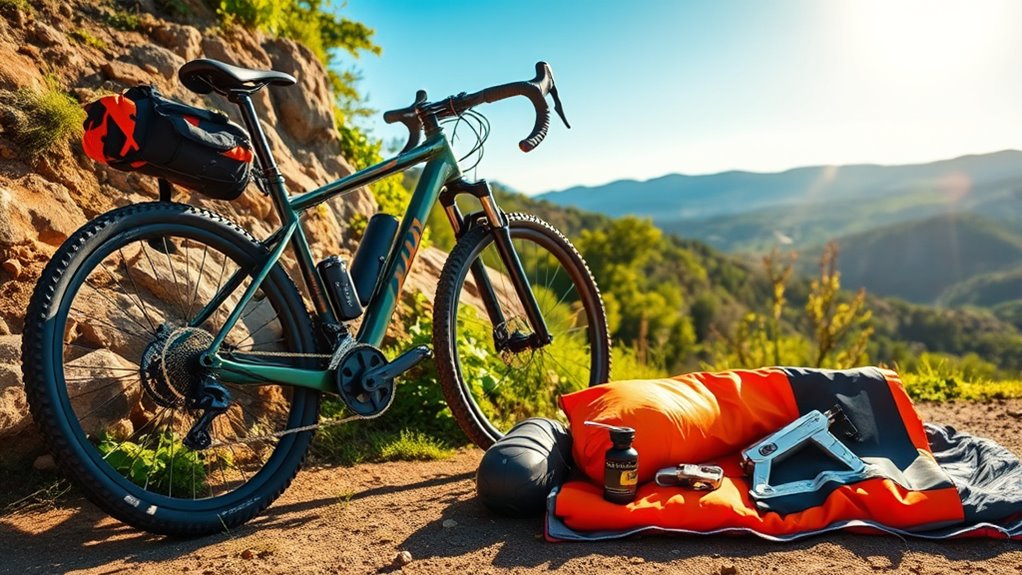
When packing for a bikepacking trip, prioritizing the right clothing and gear guarantees you’re prepared for changing conditions and comfortable throughout your ride. Start with a good pair of bike shorts; they provide comfort, reduce chafing, and are essential for long rides. Pair them with moisture wicking shirts to keep sweat away from your skin, preventing chafing and overheating. Lightweight and breathable fabrics are key, so choose clothing that dries quickly and adapts to varying temperatures. Don’t forget a layering system, including a lightweight jacket or thermal layers for colder weather. Proper gear also includes padded gloves, a hat, and sunglasses to protect against sun and debris. Packing versatile, moisture-wicking clothing ensures you stay comfortable and ready for any terrain or weather you encounter. Additionally, consider how changing gears on your bike efficiently can help you handle diverse terrains smoothly during your trip. To enhance your comfort, choosing headphones with wireless connectivity can prevent cables from tangling as you ride. Incorporating the role of color accuracy in your gear selection, such as choosing brightly colored or reflective apparel, can improve visibility and safety on the road. Being aware of Grocery Savings Strategies can also help you manage your budget in the long run, especially when planning extended trips. Moreover, organizing your gear with home organization principles can make packing and unpacking more efficient and less stressful.
Cooking and Food Supplies
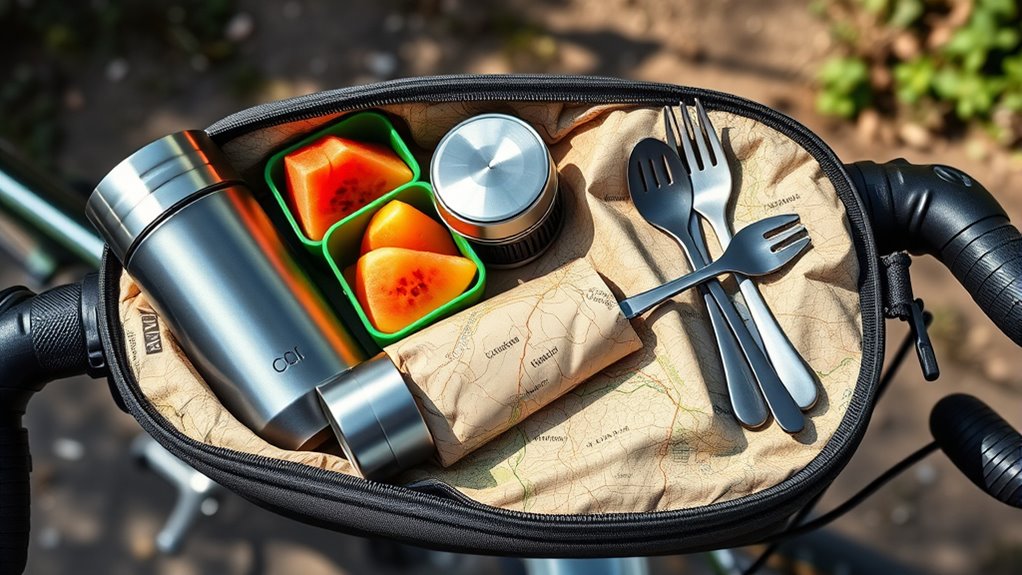
Having the right cooking and food supplies is essential to keep your energy up and make sure your trip runs smoothly. With campfire cooking and proper food storage, you’ll enjoy warm meals and avoid spoilage. Pack lightweight, durable gear like a compact stove, fuel, and utensils to make meal prep simple. Don’t forget resealable containers or vacuum bags for food storage, which keep your supplies fresh and prevent critters from getting in. Consider bringing non-perishable essentials like trail mix, energy bars, and dehydrated meals to sustain your energy levels. These items help you stay fueled and motivated, even on tough days. Proper planning ensures you won’t go hungry and can fully enjoy the adventure without worry. Using the right food storage methods can also help preserve nutritional value and prevent contamination. Additionally, choosing suitable food containers designed for outdoor use can further enhance your food safety and convenience. Incorporating eco-friendly storage solutions can also reduce your environmental impact during the trip. Regularly checking your food safety supplies will help ensure everything remains in good condition throughout your journey. To further safeguard your supplies, consider using airtight containers to prevent moisture and pests from compromising your food.
Sleeping Equipment and Comfort Items
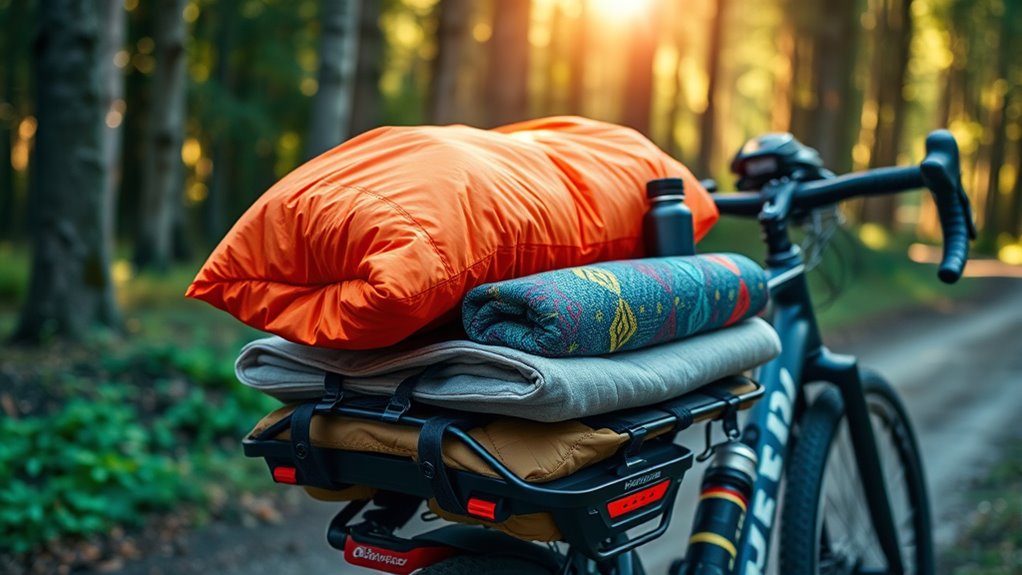
After packing your food supplies and cooking gear, it’s important to make sure you get a good night’s sleep to stay energized for each day’s adventure. Your sleep system is key to camping comfort, so choose a lightweight sleeping bag suitable for the forecasted temperatures. Pair it with an insulative sleeping pad to cushion your rest and improve thermal efficiency. Consider bringing a compact pillow for added comfort, and don’t forget a sleep mask or earplugs if noise or light might disturb you. Packing a small, quick-drying towel can also boost your overall comfort after a long day. Prioritize a reliable, easy-to-set-up sleep system to ensure restful nights, so you wake refreshed and ready to tackle new trails. Recognizing the importance of sleep comfort can also inspire confidence and positivity about future love connections during your trip. Building a sense of trust during adventures can make your journey more enjoyable and memorable. Additionally, investing in durable materials for your sleeping gear can enhance longevity and performance throughout your trip. A well-chosen sleep system rooted in quality materials can significantly improve your overall camping experience.
Navigation and Safety Tools

Equipping yourself with reliable navigation and safety tools is vital for a smooth and secure bikepacking trip. Digital maps provide real-time guidance, helping you stay on course even in unfamiliar terrain. An emergency communication device, like a satellite phone or GPS messenger, guarantees you’re connected when cell service drops. Home security systems can also be incorporated into your gear choices, making the experience more enjoyable. Consider these essential tools: – GPS device or smartphone with offline maps to confidently navigate your route – Personal locator beacon (PLB) for instant emergency alerts – Portable whistle and reflective gear to attract attention and increase visibility. Incorporating Kia Tuning techniques can also enhance your vehicle’s performance, ensuring it handles well on diverse terrains. Using protective styling benefits can also help safeguard your hair during outdoor adventures. Staying oriented, reachable, and aware of AI-driven solutions in healthcare is key to enjoying your adventure safely.
Repair and Maintenance Kits
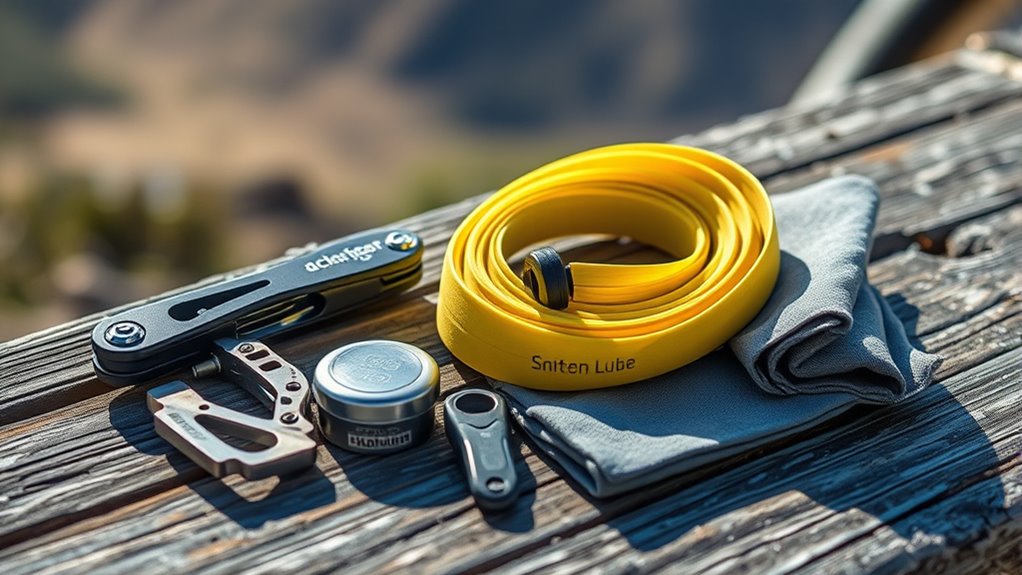
Being prepared for mechanical issues is just as important as maneuvering safely on your bikepacking trip. A well-stocked repair and maintenance kit helps you handle unexpected problems efficiently. Include spare parts like inner tubes, tire levers, and a multi-tool to fix minor issues on the trail. Tire repair essentials, such as a patch kit and CO2 inflators, are vital for quick fixes to flats. Carrying a chain link or master link helps you repair a broken chain, while spare bolts or screws can address loose components. Regular maintenance tools like lubricants and cleaning supplies ensure your bike stays in top condition. Mazda Tuning techniques can also inspire you to keep your bike in optimal shape. With these items, you’ll be ready to tackle common mechanical challenges, keeping your trip smooth and enjoyable.
Personal Items and Hygiene Products
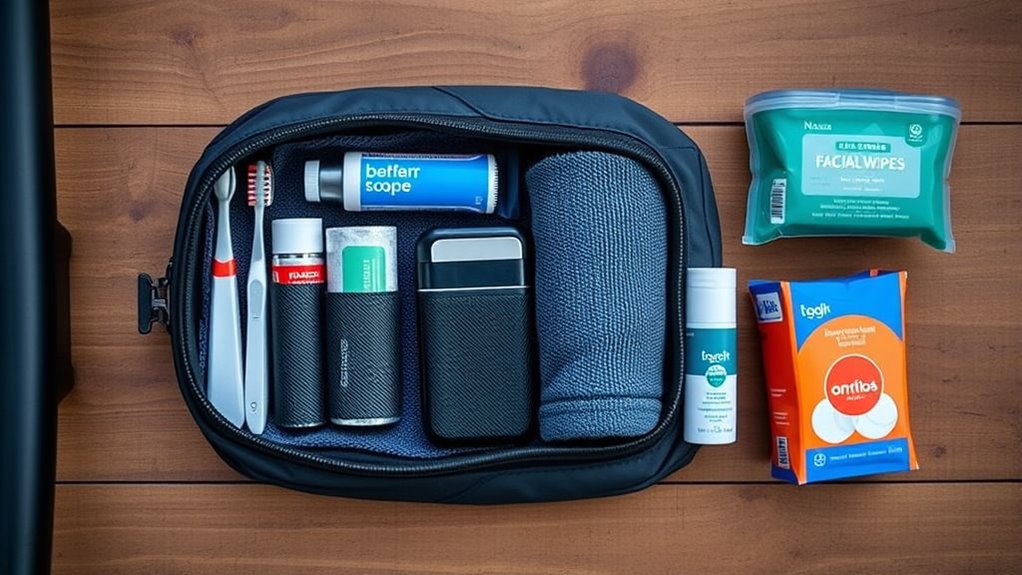
When packing for your bikepacking trip, make sure to include essential toiletries like toothbrush, toothpaste, and soap to stay clean. Keep your personal identification and money secure and accessible for any stops or emergencies. Remember to plan for hygiene on the trail with items like wipes or a small towel to stay fresh throughout your journey. Recognizing soulmate angel numbers can also help you stay spiritually centered and open to love during your adventure. Additionally, being aware of data privacy challenges can encourage you to safeguard your personal information while traveling.
Essential Toiletries to Pack
Packing essential toiletries is crucial to staying comfortable and hygienic during your bikepacking adventure. Your toiletry essentials keep you fresh and prevent discomfort on the trail. Be sure to include travel-sized hygiene products that won’t weigh you down. Think about the basics: a small bottle of soap, a toothbrush, and toothpaste. These simple items can make a huge difference in your comfort. Remember, staying clean boosts your mood and energy.
- Invigorating face wipes to feel revitalized after a long ride
- Compact deodorant to stay confident all day
- Mini hand sanitizer for quick cleanliness anytime
Packing these toiletries ensures you stay fresh and focused, making your trip more enjoyable. Don’t underestimate the power of good hygiene products—they’re your secret weapon for staying comfortable mile after mile.
Personal Identification and Money
Carrying your personal identification and money securely is essential for a smooth bikepacking trip. Use a waterproof wallet or a hidden pouch to protect your ID, credit cards, and cash from the elements and theft. Having reliable bike security measures, like a sturdy lock, keeps your belongings safe when you’re away from your gear. Don’t forget to carry a copy of your travel insurance details, in case of emergencies. Keep your ID and money close but accessible, so you can quickly show identification if needed and make purchases without hassle. Avoid carrying large amounts of cash; instead, use cards or digital payment methods when possible. Properly organizing these essentials minimizes stress and ensures you’re prepared for unexpected situations along the trail.
Hygiene on the Trail
Maintaining good hygiene on the trail is essential for comfort and health during your bikepacking trip. Proper camping hygiene and trail cleanliness keep you feeling fresh and prevent infections. Pack lightweight essentials like biodegradable soap, a small pack of wipes, and a quick-drying towel. These items help you stay clean after long rides and keep germs at bay. Remember, trail cleanliness isn’t just about personal hygiene; it’s about respecting nature by disposing of waste properly.
Consider these tips to stay fresh and hygienic:
- Use biodegradable soap to wash hands and face
- Carry wipes for quick refreshment
- Pack a compact towel for drying off and cleaning up
Staying clean boosts your mood and ensures a healthier, more enjoyable adventure.
Packing Tips for Efficiency and Accessibility
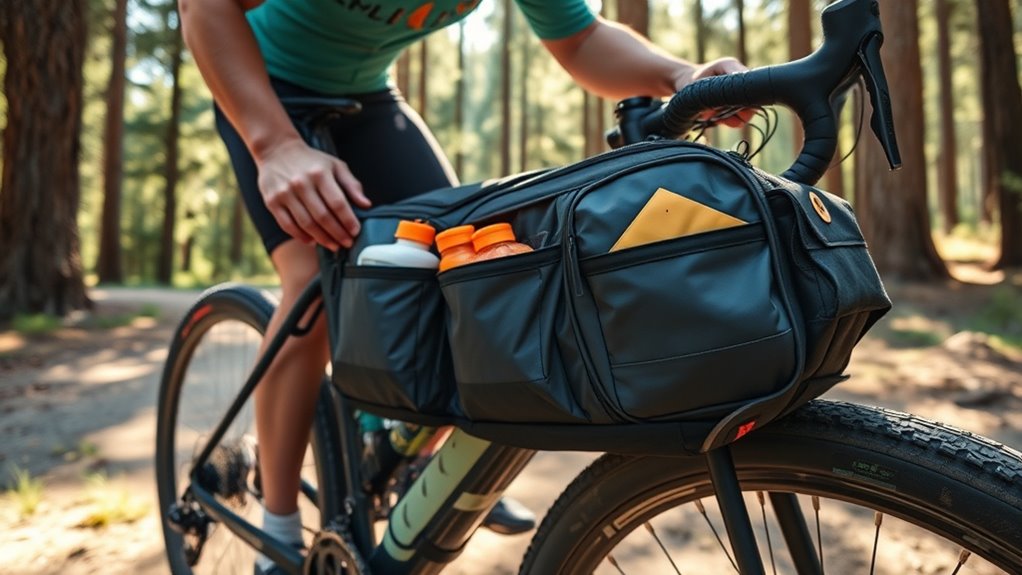
To pack efficiently, focus on prioritizing your essential items so you can access them quickly when needed. Organize your gear in a way that keeps frequently used items within easy reach, saving you time and effort on the trail. Staying deliberate with your packing guarantees a smoother, more enjoyable bikepacking experience.
Prioritize Essential Items
Since space and accessibility are limited on a bikepacking trip, it’s crucial to prioritize essential items that you’ll need most often. Effective packing techniques focus on gear prioritization to ensure quick access to your must-haves. Start by identifying the items that keep you safe, comfortable, and prepared. Keep these within easy reach, such as on top of your gear or in accessible compartments. Focus on packing lightweight, multi-use items that serve multiple purposes. Remember, every ounce counts.
Some key essentials to prioritize include:
- Navigation tools (maps, GPS)
- First aid kit
- Snacks and hydration
Organize for Easy Access
Organizing your gear for easy access guarantees you’ll find what you need quickly, avoiding unnecessary stops and frustration during your ride. Start by planning your bikepacking route and packing items based on their frequency of use. Keep essentials like snacks, maps, and tools in accessible compartments or handlebar bags, so you don’t have to unload your entire pack to find them. Group similar items together—clothing, first aid, or electronics—to streamline gear accessibility. Use small pouches or organizers within your main bags to prevent clutter and make grabbing items effortless. Proper organization ensures your gear remains secure but easy to reach, helping you stay focused on your ride without unnecessary delays. This simple step enhances your efficiency and makes your adventure much more enjoyable.
Frequently Asked Questions
How Do I Choose the Right Size Bike for My Trip?
When choosing the right bike size, focus on your bike frame size and saddle height. You want a frame that fits your height comfortably, offering enough standover clearance. Adjust the saddle height so your leg nearly straight at the bottom of each pedal stroke. This ensures efficient pedaling and reduces fatigue. Test ride different sizes if possible, and consult sizing charts or experts to find the perfect fit for your trip.
What Are the Best Ways to Prevent Gear Theft?
To prevent gear theft, you should use effective bike lock strategies, like combining a sturdy U-lock with a cable lock for extra security. Always lock your bike to a solid, immovable object, and secure both the frame and wheels. Incorporate theft deterrent devices such as alarms or GPS trackers, which can alert you or help recover your gear if someone tries to steal it. Staying vigilant and prepared keeps your gear safe.
How Should I Handle Emergencies or Injuries on the Trail?
On the trail, handling emergencies or injuries requires quick action and preparation. Always carry a well-stocked first aid kit and know basic first aid techniques. Stay calm, assess the situation, and prioritize safety. Communicate your emergency plan, like signaling for help if needed. Practice emergency preparedness before your trip, so you’re confident managing cuts, scrapes, or more serious injuries, ensuring you stay safe and comfortable until help arrives.
What Are Eco-Friendly Packing Options for Bikepacking?
Eco-friendly essentials enhance your experience by emphasizing sustainability. You should choose solar-powered chargers to spark your devices safely and sustainably, reducing reliance on disposable batteries. Reusable food containers cut down on waste, keeping the trail clean. Opt for biodegradable soaps and eco-conscious clothing to further lessen your footprint. By packing these planet-friendly products, you not only protect nature but also promote responsible riding, making your bikepacking adventure both enjoyable and environmentally ethical.
How Do I Plan for Unpredictable Weather Conditions?
When planning for unpredictable weather, you should always check weather apps before heading out, so you stay updated on conditions. Pack versatile rain gear like waterproof jackets, pants, and covers to stay dry. Layer your clothing to adapt to temperature changes, and carry a compact tarp or emergency shelter. Staying informed and prepared guarantees you handle sudden rain or chilly weather comfortably, making your ride safer and more enjoyable.
Conclusion
Now that you’re armed with this checklist, you’re basically a bikepacking legend in the making. Just imagine pedaling through landscapes, your gear perfectly packed like a well-oiled chaos machine, ready for anything from sudden rainstorms to surprise snack attacks. Remember, the goal isn’t just to survive but to look confident while lugging an entire camping store on your back. Happy riding—may your pack stay balanced and your snacks never run out!
